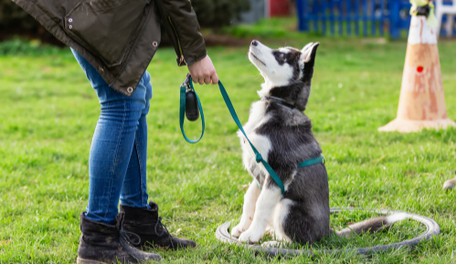Dogs are sitting properly if:
- Their front and hind legs are in line with each other
- Their feet all point to the front and not to the sides
- There are no medical issues causing a lazy sit or puppy sit
- Their owner trains them to sit in the correct position
- They are fully grown
Have you noticed how your dog sits? There are various positions a dog sits in and reasons for each. The positions can change throughout a dog’s life too.
I own a Bichon Frise called Freya, and I hadn’t thought about how she sits. So, I decided to look at the topic in more detail. I’ve brought you the facts I learned about the proper dog sitting position here.
If you want to know why dogs sit in a certain way, I’ve got the answers to save you time looking for them.
Puppies Sit Differently to Dogs

I have had Freya since she was eight weeks old. She was cute back then – and still is now.
I remember her being quite uncoordinated as she raced around the house, discovering new things to play with and places to go. As she grew, her legs seemed to get longer before the rest of her caught up.
Whenever she sat down, her back legs went off to the side. I now know to call it the puppy sit. Some call it the lazy sit because it looks casual!
There’s a reason for this though. When puppies are young, their muscles, ligaments, and joints are still growing. They cannot always sit in the proper position. If they manage it, they may not be able to hold it for long.
Freya could do it when I taught her to sit for a treat. She learned that one fast enough! If she sat for any other reason, though, she’d usually do the lazy sit.
Myth alert! Do not worry if your puppy always adopts the puppy sit during their first two years of life. Some new owners fret that their pup has hip issues. Puppies are big on flexibility when they’re young. That’s why the puppy sit earned its name.
You should only be concerned if you train your puppy to adulthood, and the issue persists.
The Lazy Sit Should Vanish Around Two Years Old
Most dogs reach adulthood by this age. It means their ligaments are strong enough to hold them in a proper sitting position. Their back legs should no longer go off to one side.
Dogs won’t learn this by themselves though. If they always use the lazy sit, they might continue to do it. Make sure you train them to sit in the proper position whenever you ask them to. They’ll take their cues from you.
Dogs Should Sit Up Straight
Would it surprise you to learn this is the straight sit?
Your dog should face you, with its front legs in front of its body. It should sit on its hind legs. These should be in line with its front legs to show the straight position.
They should position their feet in line with the legs, pointing to the front instead of out to one side. If you train your dog to sit while on a walk, this is the position to go for.
Training Your Dog to Sit Properly

As with all training, you need to put in regular effort with your dog. Teaching your dog to understand the sit command is just the start. You need to make sure they sit correctly too.
You can help move your dog into position, but this can be difficult to do. One website suggested using a small box or similar small space your dog can fit in. This means your dog would not be able to sit with its legs out to one side.
Another suggestion involved using a platform. If your dog sits in the correct way, provide them with praise and a treat. Freya always responds well to training while using treats. This might work well for you and your dog too.
The aim is to try this several times a day until your dog understands the right position to sit in.
Of course, you want your dog to sit properly without needing a tray, box, or platform to do it. You need to remove your training aid once they get the hang of it. Eventually, you will remove the treats too. Praise alone should be enough – Freya loves it!
Side Sitting May Indicate a Problem

An animal chiropractor website revealed that the lazy sit might suggest an issue if a dog continues to do it after two years of age.
A dog that often (or always) sloppily sits down may suggest an issue in one of three areas:
- The hips
- The knees
- the back
With hip and knee problems, you can usually spot the affected side of the body by figuring out which way they sit. The stretched-out side is likely to show the problem area.
Problems can include:
- Joint problems
- Arthritis
- Inflammation
Always see your vet to find out more. Once you know whether your dog has a medical issue or simply doesn’t know how to sit properly, you can work out how to help them.
I can supply a good personal example of this. I know that Freya is prone to a luxating patella. This means her rear left kneecap sometimes slips out of place before going straight back in again.
The vet said it could require surgery if it popped out and didn’t go back in. It’s common among small dogs. A dog doesn’t always need surgery unless the condition gets bad or causes a lot of pain.
The vet suggested that gradually building up to longer walks can help alleviate the issue. It strengthens the ligaments and muscles around the knee. So, I tried that. It helps that she loves her walks. If we keep up those walks, she rarely ever hops like she used to. Every third or fourth step was a hop. Now, I rarely spot her doing it.
While I was writing this article, I also realized that Freya doesn’t sloppy sit like she used to. She still does it occasionally, but everything I have read suggested that the occasional puppy sit in an adult dog doesn’t cause harm.
The trick is to be alert to any unusual behavior. If your dog doesn’t usually do the lazy sit but they begin doing so, it’s good to see your vet for advice. In some cases, it could be because the owner hasn’t trained their dog to sit properly though.
Other Sitting Positions Can Indicate an Issue Too
It’s not just the lazy sit you should be aware of. One article showed a photo of a dog sitting straight but with both rear paws out to the sides. The dog in question suffered from hip arthritis. The position clearly reduced some discomfort for the dog.
It illustrates why seeking professional veterinarian advice is important if your dog continually sits in anything other than the proper dog sitting position. The sooner you recognize a medical problem (if there is one), the sooner your dog is going to feel more comfortable.
Your dog might need anti-inflammatory medicines for these issues. Surgery sometimes improves certain conditions. A change in their diet can help too in some cases. Professional advice certainly helps in all situations.
The Lazy Sit Doesn’t Cause Problems
Some people think a lazy sitting position causes back pain, knee pain, or other medical issues. It doesn’t. My research suggests it’s the opposite way around.
The proper sitting position is the most sensible one a dog can use. They’ll only adopt another position if the proper one is uncomfortable for some reason.
Some Dogs Imitate Human Sitting Positions
It can be amusing to see your dog sitting like this. My research suggests it is mimicking behavior too.
If your dog tries it and you respond positively, they might do it more often. It is also more likely to occur in bigger dogs with longer legs. They find it comfy, while smaller dogs wouldn’t.
Freya has never done this (unless she does it at night in her sleep).
Your Dog Might Also Sit Next to You
Sometimes, I can sit on the sofa and Freya will sit next to me on the floor. The lazy sit means she can nudge up against my leg. It’s a protective thing – a bond with her owner.
You can see there are assorted reasons why the proper dog sitting position might not always happen. Now you know what to look for and when, you can make sure your dog is sitting properly.

Sources:
https://pawleaks.com/dog-sitting-positions-what-they-mean/
https://www.pawsitivestepsrehab.com/blog/achieving-the-perfect-sit/
https://www.dogs4motion.com/en/blog/510-the-importances-of-proper-sitting-in-dogs
https://www.cesarsway.com/15-photos-of-dogs-sitting-in-strange-positions/
https://www.micadogtraining.com/teach-sit-can-make-big-difference/
https://k9therapeutics.com/dog-posture/
https://www.preventivevet.com/dogs/how-to-teach-your-dog-to-sit

